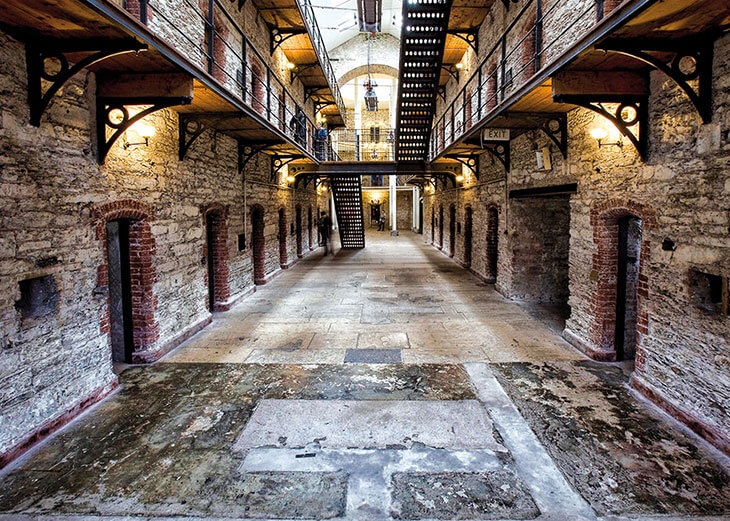Discover Our History
Step back in time to see what 19th and early 20th-century life was like inside prison walls.
Cork is a city with a very rich historical and archaeological heritage much of it still in evidence today. Part of this heritage, Cork City Gaol, is a magnificent castle-like building which once housed 19th century prisoners. Take a trip back in time and wander through the wings of the Gaol, accompanied by the shuffling feet of inmates and the jingle of the warders’ keys.
While the tour of Cork City Gaol focuses on the unknown prisoners, there was a number of well-known people who were incarcerated here for a number of different (mainly political) reasons.


1840s
The Young Ireland movement was a political and cultural movement that was active in the 1840s. The Young Irelanders encouraged the study of Irish history and the Irish language as a way to develop a sense nationalism in order to achieve independence. After a failed rebellion in 1848 a number of its members were imprisoned in Cork City Gaol. Those imprisoned included: Denny Lane, Terence Bellew McManus, Ralph Varian, Isaac Varian.
1860s
The Fenian movement embodied the Young Ireland ideals and also supported the idea of a revolution. A rising was planned for late in 1865 but the government, alerted by spies within the organisation, arrested and imprisoned the leaders and other suspects. Among those imprisoned in Cork City Gaol were: Brian Dillon, John Sarsfield Casey and James Mountaine.
1880s
The Irish National Land League was a political organisation which aimed to help poor tenant farmers. Hannah Reynolds, a member of the Ladies land league, was arrested for offering to help tenants who were about to be evicted from their homes. She was sent to Cork City Gaol for 1 month after refusing to pay a fine.
1910s
Countess Constance Markievicz was sentenced to 4 months here in 1919. She was an officer in the Irish Citizens Army in 1916 when she fought in St Stephens Green. She was the first woman to be elected to the British Parliament, although she refused to take her seat, instead she became Minister for labour in De Valeras provisional government.
1920s
Frank O’Connor, born Michael O’Donovan, was a famous short story writer who was born in Cork. He was briefly imprisoned in Cork City Gaol during the Civil War.
When the prison opened in the 1820s, it housed both male and female prisoners whose crimes were committed within the city boundary. Those who committed a crime outside that boundary were sent to Cork County Gaol, across the river from the City Gaol near University College Cork.
In 1922 and 1923, the prison was opened to male and female Republican (anti-treaty) prisoners of the Irish Civil War.
One of those imprisoned at the time was the writer Frank O'Connor.
A spectacular escape was made from the gaol in November 1923. The escapees were high-value prisoners who had been sent to the gaol as it was "the safest place to hold them". Some men had feigned illness on the night preceding the escape. A rope ladder was made to scale the outer wall, and bed clothes were used to descend to the ground by night. After the prisoners had lowered themselves to the ground inside the wall, they had to huddle in its shadow in sight of a sentry. The position of the moon at a certain hour had to be estimated in order to conceal the movements of the men in the shadows. They went in batches of fourteen as that was the number that could fit in the shadow of the wall, the most wanted men being given preference in order of the serious nature of their charges. All the men in the first batch were liable to the death penalty and cast lots for the order in line. When number nine went over the wall some noise attracted the sentry, and he made movements which caused the prisoner to balk. After a few moments silence, the action was resumed, and three batches amounting to forty two men, escaped with a lapse of fifteen minutes between each batch. It was a frosty night and they had to travel in stockinged feet. Some of those who escaped were natives of Cork City and got clear of there before daylight, but others in the last few batches were recaptured later in the day.
The gaol closed in August 1923, with all remaining prisoners either released or transferred to other prisons.
Many of the prisoners in the late 19th century were repeat offenders locked up for what would not today be imprisonable offences; for example, a woman named Mary Tucker from Rathmore in County Cork was imprisoned at least three times between 1849 and 1908, sometimes for offences such as 'Obscene Language' or ‘Drunkenness’.

Julia Twomay.


Constance de Markievicz

During the 1860s the authorities of the time expected that prisoners would be given a minimum standard of food.
In Irish gaols bread, Indian meal (com), gruel and milk were the mainstay of the prisoners’ diet. Although the more wealthy inmates could sometimes pay for alternative food to be brought in from the outside. Prisoners were given just enough let them carry out their work and prevent them getting sick, but no more than that. A prisoner’s diet could also be determine bv the length of their sentence - for example, for those serving a short sentence milk would be replaced by and less nutritious oatmeal gruel on the basts wouldn’t be them long enough to get really sick! 30% of meat was given to longer serving prisoners on hard-labour as they required more nutrition. For those held in solitary, nothing plain bread and water is what they could expect each day.








